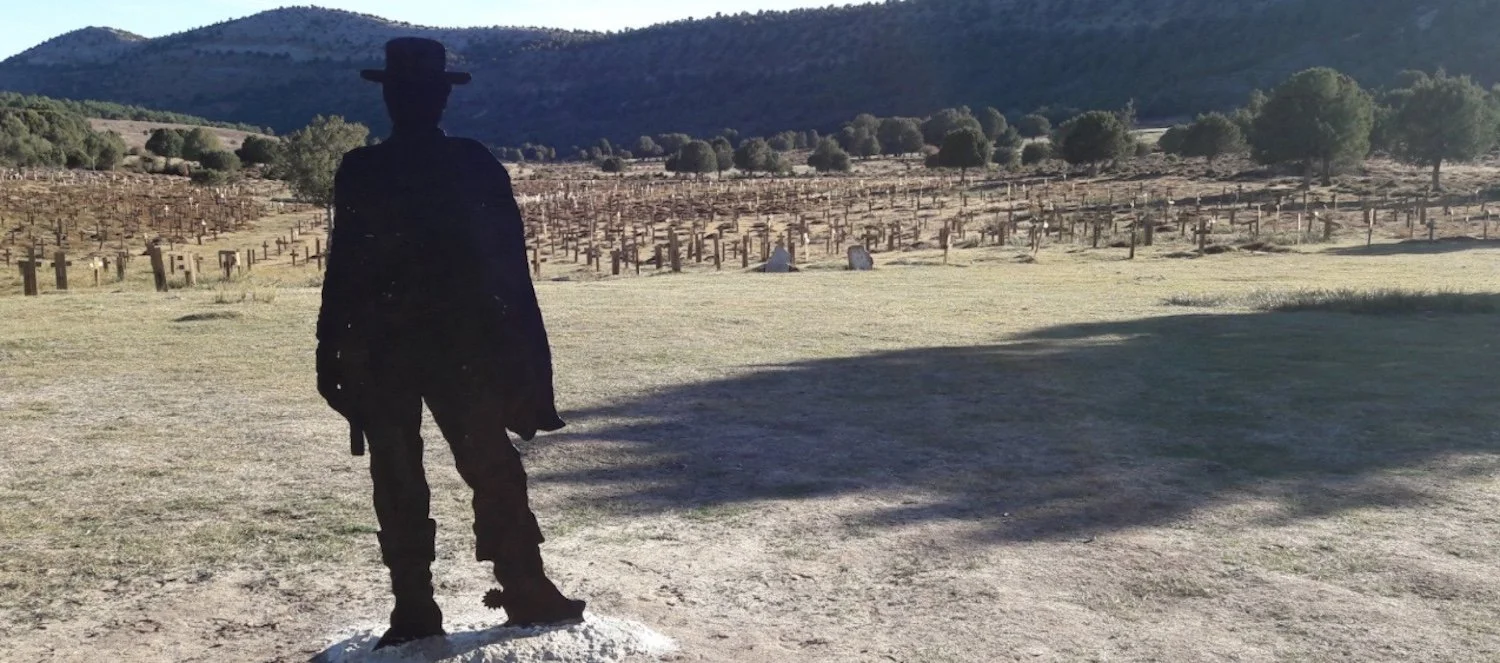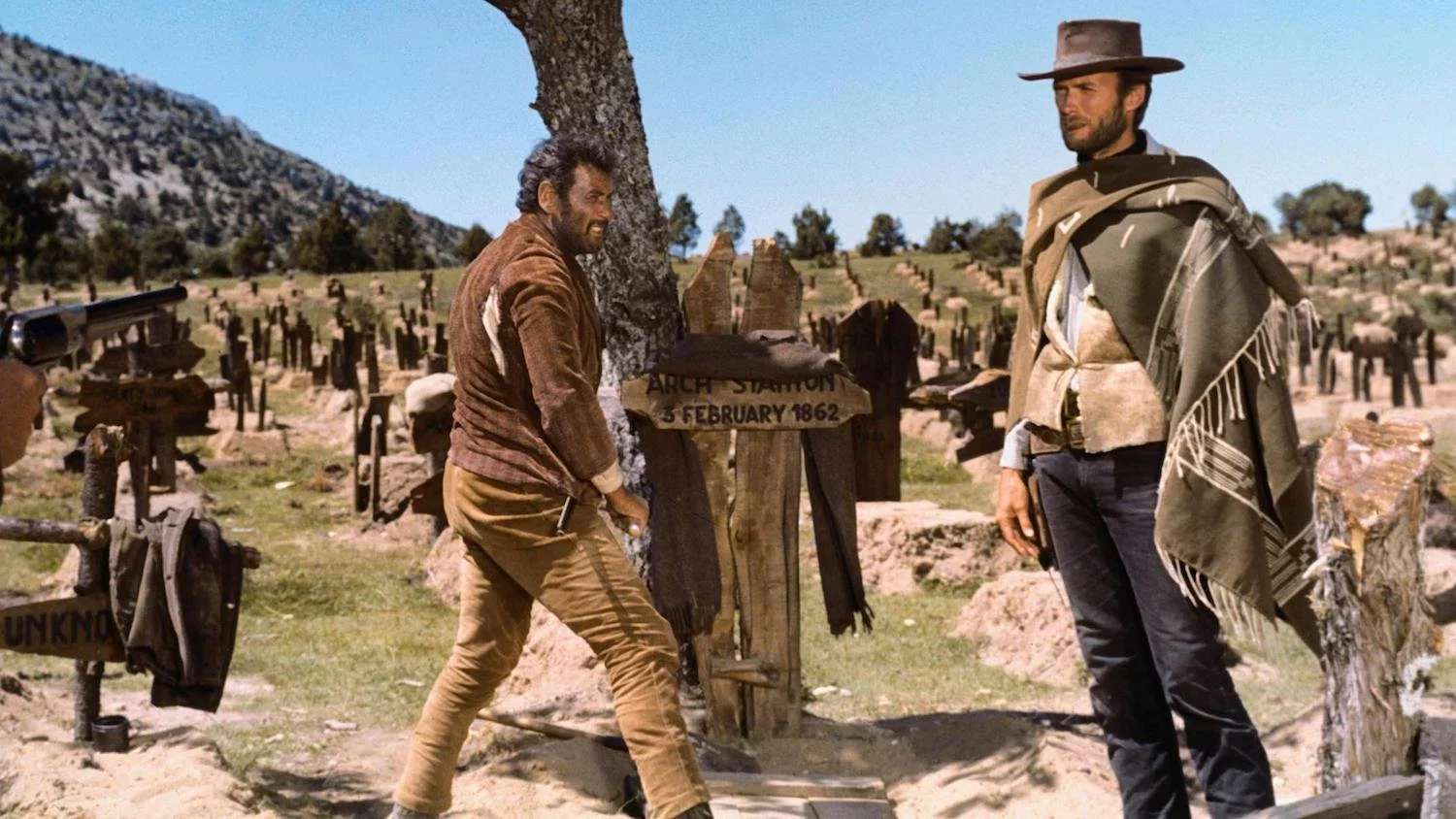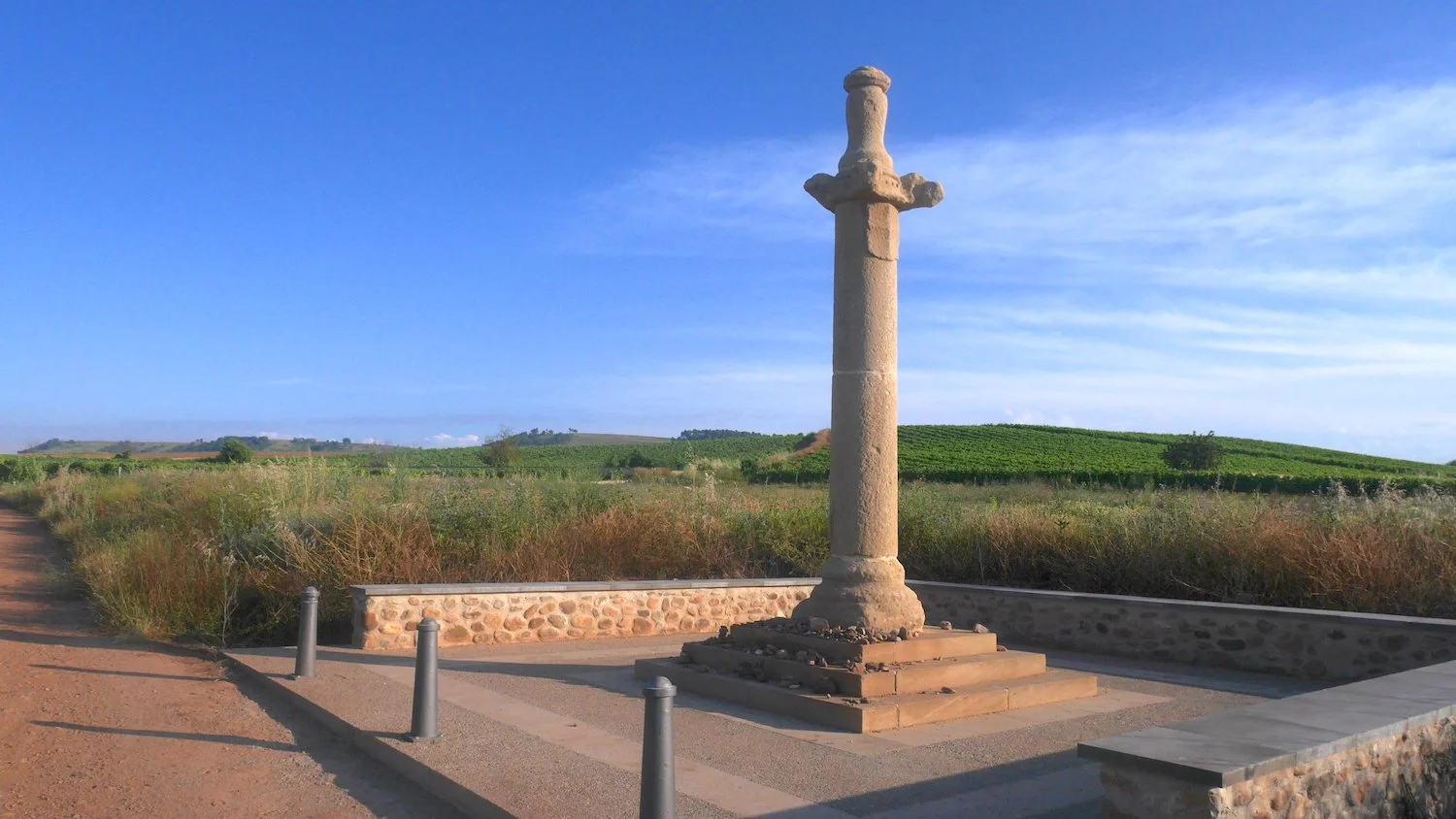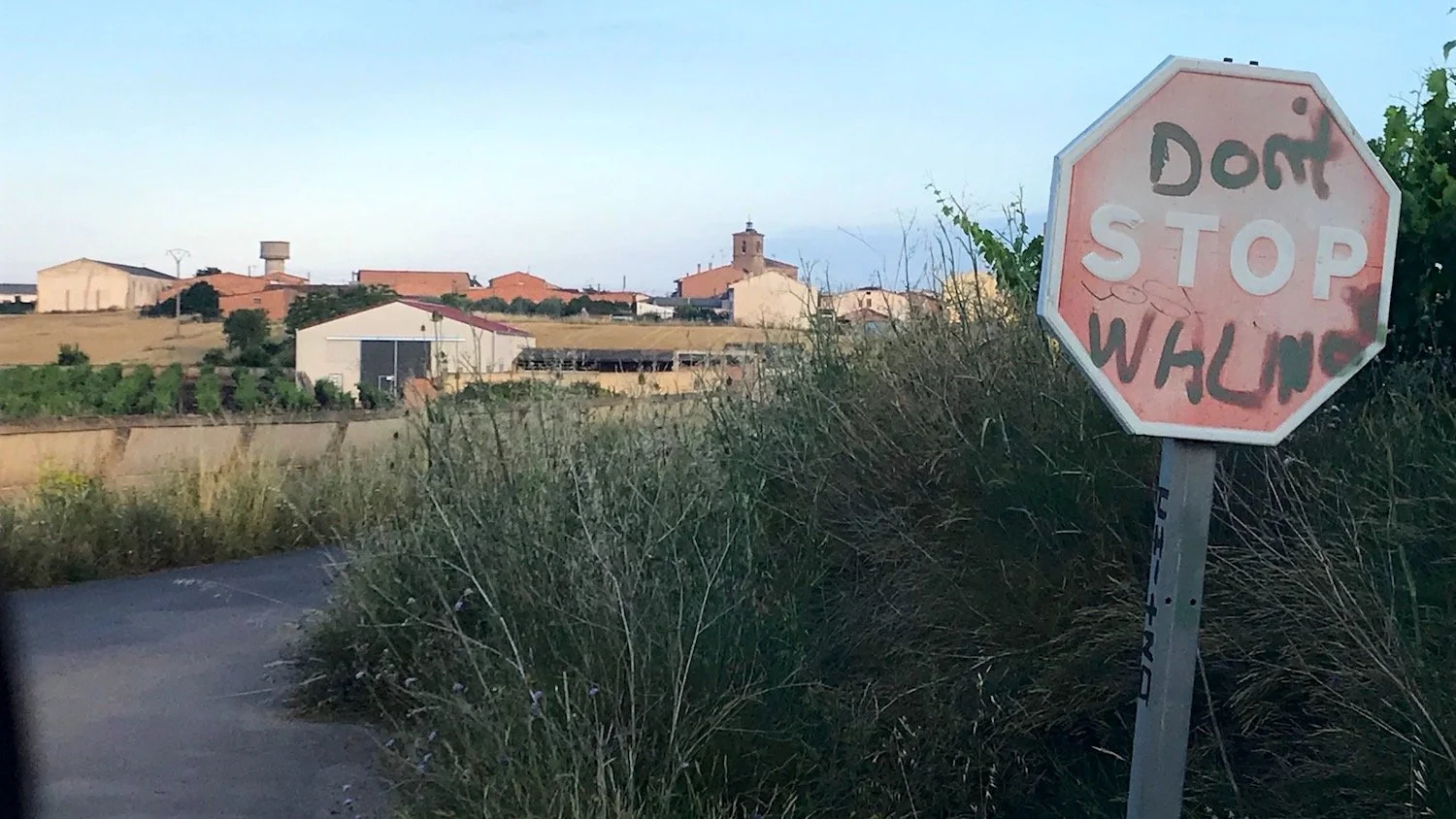Spaghetti Westerns made Clint Eastwood. And Spain made spaghetti westerns.* Maybe they should be called tortilla westerns?
Case in point: the last showdown in The Good, the Bad, and the Ugly (1966) was filmed in the hills near Burgos, Spain, about ten miles from our position. The fictitious Sad Hill cemetery is there to this day (and visited by Eastwood aficionados. See the brief video linked here if that includes you). On this day, it was too much of a detour for our legs.
Eli Wallach and Clint Eastwood at the Sad Hill cemetery in The Good, the Bad and the Ugly. In this scene Spain played the role of New Mexico. Image from here (accessed 12/17/2021).
It was just as well. We were having some good, bad, and ugly experiences of our own.
We left Nájera after a bad night. It was still dark at 5:30 am when we walked out of the stuffiest hostel in the country. It was a good morning though. The sun pushed off the horizon into blue sky.
The trail cut through the bluffs of the Río Najerilla basin and led across a gently rolling grassland. The landscape was punctuated with an occasional village, vineyard, or isolated stand of wood.
An important civic monument marks the exit of the town of Azofra. It appears as a scroll rising from the ground.
Somewhere along the way, Talking Woman fell into our company. Talking Woman was a middle-aged American doing the Camino solo. Little did we know that she had been saving her sprawling narrative for such a time as this. She unloaded it on Bob and me as gently as a rattleboned Viking at a smörgåsbord. It was a stream-of-consciousness monologue (complete with flashes of teeth) that bounced around from last night’s chorizo (served with saffron rice) to a soured friendship that started in an amazing way during my sophomore year of high school to the curious habits of small birds just like the speckled one that landed on the fence over there to what really goes nicely with rabbit stew (ugh, can you believe people eat rabbits!) and so on and so forth. I nodded like a dashboard bobblehead until my neck began to ache. Then I just looked straight ahead. Every half hour or so, I shot her a glance. Her stamina was incredible. I figured at some point she had to inhale or would pass out all blue and gaspy.
Neither happened.
Bob looked over at me. I could see the pleading in his eyes. What could I do? Pick up the pace? Sprint? Fake a collapse of my own? There was no escape!
Talking Woman fell into the quiet company of Bob and Mark on a road without end.
As we approached the village of Cirueña, a plan formed in my mind. We had a bit of left-over grocery in the pack. I interrupted Talking Woman with the “(Sigh) Well-this-sure-has-been-fun,-but-we’ll-see-you-later-because-we-need-to-stop-and-eat-our-lunch-right-now” goodbye. “Buen Camino!”
It didn’t work.
“No problem. I can eat with you.”
The three of us sat down on a bench beside the trail. As we munched bread and cheeses, another solo traveler approached. He was a lean, muscley man with no shirt. His skin was tanned from the sun and covered in tattoos and maybe a few scars.
“Gooddaye,” he nodded. He had a Welsh accent.
Talking Woman went silent.
We exchanged a few pleasantries then he pushed off.
After he was beyond earshot, Talking Woman erupted afresh and told us that this man had been in the hostel she had stayed at last night. He scared everyone to death practicing lunges and punches and high kicks in the yard. If that wasn’t enough, he then flashed a knife at dinner and laughed like a maniac at the shocked response of the others.
“It was huge. I’m sure he did prison time. Probably killed somebody.”
It was a horrible thought, thinking about an encounter with Mad Jac MacKnife in a lonely canyon, or worse, having him occupy the bunk below you with nothing but a thin mattress separating your stomach from his blade.
We knew the Camino’s reputation for absolution and clemency; still, we shuddered.
After lunch, Talking Woman accompanied us into the next village, Santo Domingo de la Calzada. There, she abruptly said goodbye and scurried off in the direction of a hotel.
Encouragement may be found in odd places: “Don’t stop walking.”
Bob and I recovered in the sanctity of silence. Then we continued. We aimed to make one more village before calling it a day.
The rising wind whistled across swaths of brittle-brown grass. The stalks bent as it passed. A thunderstorm brewed to our west. It was a scene straight out of High Plains Drifter.
The trail took us to the village of Grañón, a lonely place with a few hundred residents. It was perched on a hill and centered on an old church house, the Hospital de peregrinos San Juan Bautista (or the “Saint John the Baptist Pilgrims’ Hospital”). The “hospital” was highly recommended in the guidebook for its close communal experience.
We signed in and went upstairs. There we found an attic room where plastic-covered pilgrim mats lined the wooden floor. Laundry lines stretched across the space and into the adjacent belfry. Clothespins swung slowly from ropes as the rising air outside moved through the creaking structure. Bob and I chose our mats, positioned them under the rafters, and deposited our stuff.
Outside, it was gusting. Ragged clouds filled the blue sky.
Scenes from Grañón.
We thought it best to resupply before the rain hit, so we went to the grocery. On the way back, we ran into Kay, an old trail buddy and teacher from Oklahoma City. She was on the way out of our hostel, wide-eyed and shaking.
“He’s here,” she exclaimed.
“Who"?”
“The Welshman with the knife! He’s threatening people. I’m not staying here.”
Bob and I looked at each other for a moment, then ran upstairs to the attic space.
Mad Jac MacKnife crouched on the mat RIGHT BESIDE MINE! He didn’t raise his head or speak.
Bob and I gingerly packed our things. We moved deliberately to the stairs, and once down, sprinted out the door into the rain-dark streets of Grañón.
¡Buen Camino!
We have a full slate of Bible Land trips ready to launch in 2022. Check out a complete list by clicking here or peruse under the heading “Find your Trip.” For more information on how to join one of these trips or if you are interested in helping to craft a unique trip for your own group, church, or school, contact me at markziese@gmail.com.






